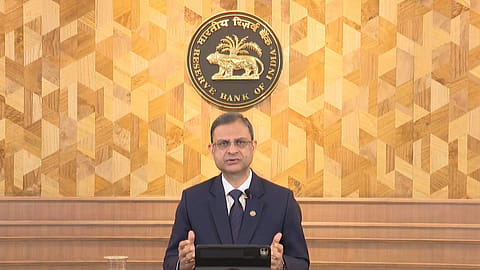RBI raises FY26 GDP projections to 6.8%; tariffs pose downside risks, says RBI Governor
RBI Governor Sanjay Malhotra said in a statement that the implementation of several growth-inducing structural reforms, including streamlining of GST, is expected to offset some of the adverse effects of the external headwinds.

Thee Reserve Bank of India today revised its FY26 GDP growth projection upwards to 6.8% from 6.5% but cautioned against global tariff uncertainties and geopolitical tensions, which may pose downside risks to the growth outlook.
Announcing the monetary policy committee decision to maintain status quo on the policy repo rate at 5.5%, RBI Governor Sanjay Malhotra said, “Ongoing tariff and trade policy uncertainties will impact external demand. Prolonged geopolitical tensions and volatility in international financial markets caused by risk-off sentiments of investors pose downside risks to the growth outlook. The implementation of several growth-inducing structural reforms, including streamlining of GST, is expected to offset some of the adverse effects of the external headwinds.”
“Taking all these factors into account, real GDP growth for 2025-26 is now projected at 6.8%, with Q2 at 7.0%, Q3 at 6.4%, and Q4 at 6.2%. Real GDP growth for Q1:2026-27 is projected at 6.4%. The risks are evenly balanced,” Malhotra said.
“Economic activity has remained resilient with growth of real gross domestic product (GDP) surprising on the upside at 7.8% and gross value added (GVA) at 7.6% for Q1: 2025-26,” RBI said.
“As suggested by high-frequency indicators available so far, domestic economic activity continues to sustain momentum in Q2:2025-26. Looking ahead, an above normal monsoon, good progress of kharif sowing and adequate reservoir levels have further brightened prospects of agriculture and rural demand. Buoyancy in the services sector, coupled with steady employment conditions, is supportive of demand, which is expected to get a further boost from the rationalisation of GST. Rising capacity utilisation, conducive financial conditions, and improving domestic demand should continue to facilitate fixed investment,” the governor said in the statement today.
“Since the August policy meeting, significant developments on the domestic front amidst a fast-changing global economic landscape have altered the narrative on growth-inflation dynamics in India. Buoyed by a good monsoon, the Indian economy continues to exhibit strength by registering a higher growth in Q1:2025-26. At the same time, there has been a considerable moderation in headline inflation,” Malhotra said.
He said GST reforms will stimulate consumption and economic growth. “The rationalisation of the goods and services tax (GST) rates is likely to have a sobering impact on inflation while stimulating consumption and growth. Tariffs on the other hand will moderate exports,” he said.
Recommended Stories
He said the global economy has been more resilient than anticipated, with robust growth in the US and China. “The outlook, however, remains clouded amidst elevated policy uncertainty. Inflation has remained above respective targets in some advanced economies, posing fresh challenges for central banks as they navigate the shifting growth–inflation dynamics,” he said.
“Financial markets have been volatile. The US dollar strengthened after the upward revision of US growth numbers for the second quarter, and treasury yields hardened recently as expectations of rate cuts by the Federal Reserve ebbed. Equities have remained buoyant across several advanced and emerging economies,” he added.